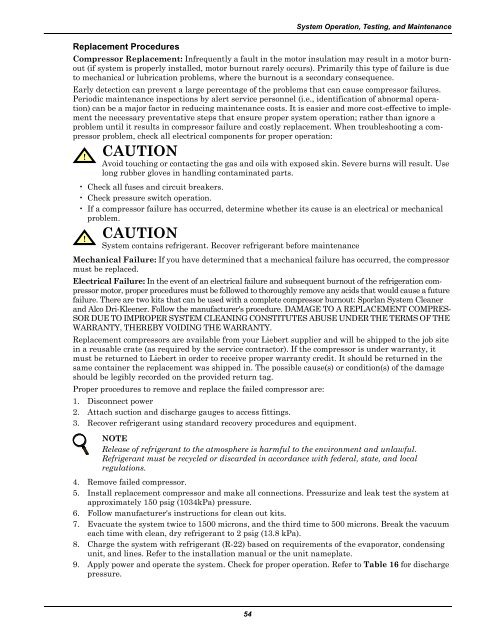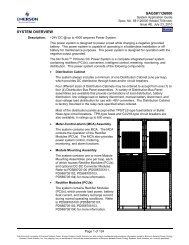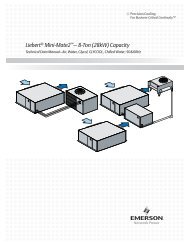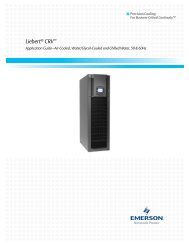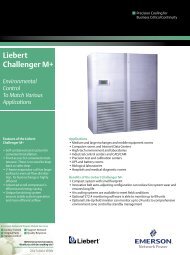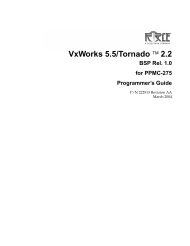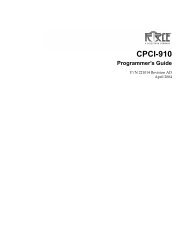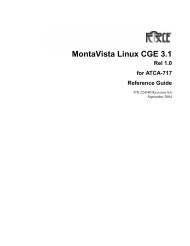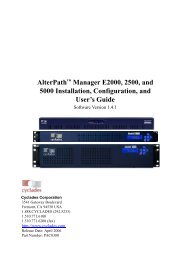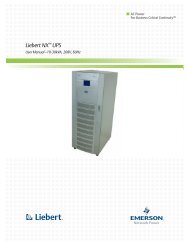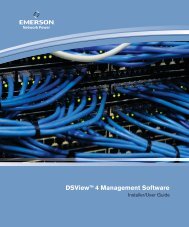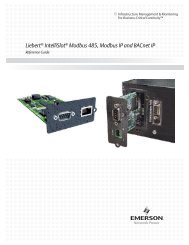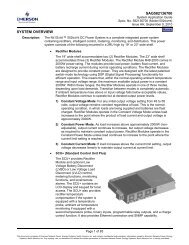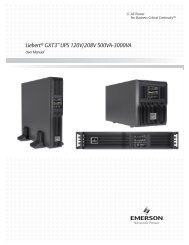Liebert Mini-Mate2, 8 Ton - Emerson Network Power
Liebert Mini-Mate2, 8 Ton - Emerson Network Power
Liebert Mini-Mate2, 8 Ton - Emerson Network Power
Create successful ePaper yourself
Turn your PDF publications into a flip-book with our unique Google optimized e-Paper software.
54<br />
System Operation, Testing, and Maintenance<br />
Replacement Procedures<br />
Compressor Replacement: Infrequently a fault in the motor insulation may result in a motor burnout<br />
(if system is properly installed, motor burnout rarely occurs). Primarily this type of failure is due<br />
to mechanical or lubrication problems, where the burnout is a secondary consequence.<br />
Early detection can prevent a large percentage of the problems that can cause compressor failures.<br />
Periodic maintenance inspections by alert service personnel (i.e., identification of abnormal operation)<br />
can be a major factor in reducing maintenance costs. It is easier and more cost-effective to implement<br />
the necessary preventative steps that ensure proper system operation; rather than ignore a<br />
problem until it results in compressor failure and costly replacement. When troubleshooting a compressor<br />
problem, check all electrical components for proper operation:<br />
! CAUTION<br />
Avoid touching or contacting the gas and oils with exposed skin. Severe burns will result. Use<br />
long rubber gloves in handling contaminated parts.<br />
• Check all fuses and circuit breakers.<br />
• Check pressure switch operation.<br />
• If a compressor failure has occurred, determine whether its cause is an electrical or mechanical<br />
problem.<br />
! CAUTION<br />
System contains refrigerant. Recover refrigerant before maintenance<br />
Mechanical Failure: If you have determined that a mechanical failure has occurred, the compressor<br />
must be replaced.<br />
Electrical Failure: In the event of an electrical failure and subsequent burnout of the refrigeration compressor<br />
motor, proper procedures must be followed to thoroughly remove any acids that would cause a future<br />
failure. There are two kits that can be used with a complete compressor burnout: Sporlan System Cleaner<br />
and Alco Dri-Kleener. Follow the manufacturer's procedure. DAMAGE TO A REPLACEMENT COMPRES-<br />
SOR DUE TO IMPROPER SYSTEM CLEANING CONSTITUTES ABUSE UNDER THE TERMS OF THE<br />
WARRANTY, THEREBY VOIDING THE WARRANTY.<br />
Replacement compressors are available from your <strong>Liebert</strong> supplier and will be shipped to the job site<br />
in a reusable crate (as required by the service contractor). If the compressor is under warranty, it<br />
must be returned to <strong>Liebert</strong> in order to receive proper warranty credit. It should be returned in the<br />
same container the replacement was shipped in. The possible cause(s) or condition(s) of the damage<br />
should be legibly recorded on the provided return tag.<br />
Proper procedures to remove and replace the failed compressor are:<br />
1. Disconnect power<br />
2. Attach suction and discharge gauges to access fittings.<br />
3. Recover refrigerant using standard recovery procedures and equipment.<br />
NOTE<br />
Release of refrigerant to the atmosphere is harmful to the environment and unlawful.<br />
Refrigerant must be recycled or discarded in accordance with federal, state, and local<br />
regulations.<br />
4. Remove failed compressor.<br />
5. Install replacement compressor and make all connections. Pressurize and leak test the system at<br />
approximately 150 psig (1034kPa) pressure.<br />
6. Follow manufacturer's instructions for clean out kits.<br />
7. Evacuate the system twice to 1500 microns, and the third time to 500 microns. Break the vacuum<br />
each time with clean, dry refrigerant to 2 psig (13.8 kPa).<br />
8. Charge the system with refrigerant (R-22) based on requirements of the evaporator, condensing<br />
unit, and lines. Refer to the installation manual or the unit nameplate.<br />
9. Apply power and operate the system. Check for proper operation. Refer to Table 16 for discharge<br />
pressure.


